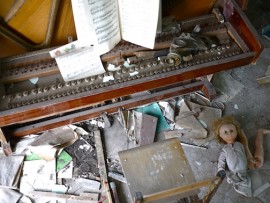Chernobyl, Ukraine
Pollutant: Radioactive dust including uranium, plutonium, cesium-137, strontium-90, and other metals
Population Affected: Up to 10 million
Chernobyl is internationally recognized as one of the worst nuclear disasters in history. On the evening of April 25, 1986, testing in the Chernobyl power plant 62 miles north of Kiev triggered a massive meltdown of the reactor’s core releasing more than 100 times the radioactivity of the bombs dropped on Hiroshima and Nagasaki. Around 150,000 square kilometers of land was affected in the accident. To this day, the 19-mile exclusion zone around the plant remains almost entirely uninhabited. Within seven months, the reactor was buried in a concrete casing designed to absorb radiation and contain the remaining fuel. However the structure was only intended to be a temporary solution and designed to last no more than 20-30 years.[1] Estimates put the number of people at risk in Ukraine, Russia, Moldova and Belarus at between 5 and 10 million, and officials believe the accident was responsible for some 4,000 cases of thyroid cancer.[2],[3]
Radioactive contamination from the Chernobyl Power Plant spread over 40% of Europe and parts of Asia, North Africa, and North America immediately following the nuclear disaster. Nearly 400 million people resided in territories that were contaminated with radiation at a level higher than 4 kBq/m2.[4] Today, there are over a dozen artificial radionuclides such as cesium-137 that can be detected in the surface soil around the plant. They are all documented as being well above the recommended levels. Internal exposure from radionuclides deposited on the ground and ingestion of contaminated foods produced in contaminated areas remain the major pathways. As a result of prolonged low-dose exposure, an article published in Environmental Health Perspectives in 2012 concluded via a nested case-control study that there has been a significant increase in the risk of leukemia.[5]
[1] The World Nuclear Association, 2013. Available at: http://www.world-nuclear.org/info/Safety-and-Security/Safety-of-Plants/Chernobyl-Accident/#.UmAqW-DPY-c
[2] CNN: After Chernobyl, complexity surrounds local health problems; August 19, 2013. Avaialable at: http://www.cnn.com/2013/08/18/health/helping-chernobyl-children/
[3] Nuclear Energy Institute: Chernobyl Accident and It’s Consequences; July, 2011. Available at: http://www.nei.org/Master-Document-Folder/Backgrounders/Fact-Sheets/Chernobyl-Accident-and-Its-Consequences
[4] Taira, Y et al. "Vertical Distribution and Estimated Doses from Artificial Radionuclides in Soil Samples around the Chernobyl Nuclear Power Plant and the Semipalatinsk Nuclear Testing Site." PLoS One 8.2 (2013).
[5] Zablotska, LB et al. "Radiation and the Risk of Chronic Lymphocytic and Other Leukemias among Chornobyl Cleanup Workers." Environmental Health Perspectives 121.1 (2013): 59-65




